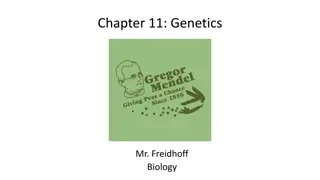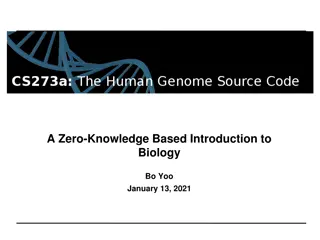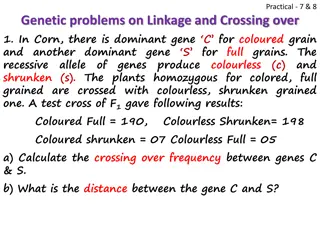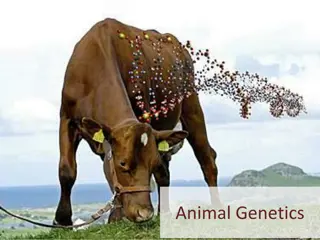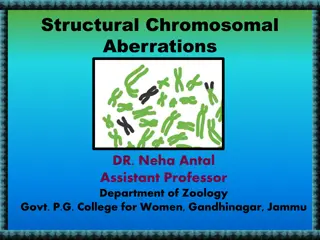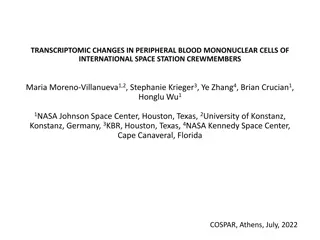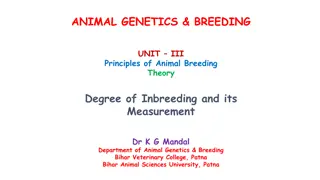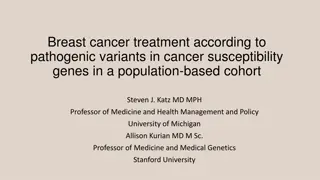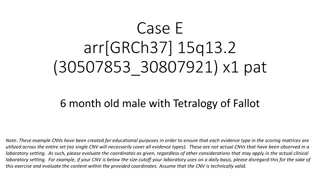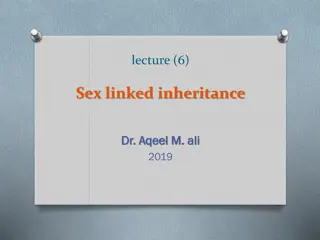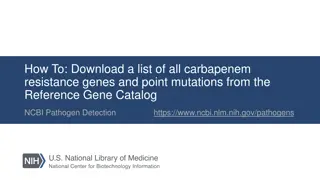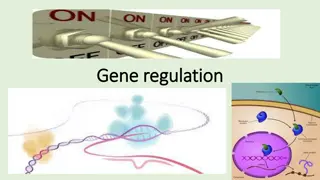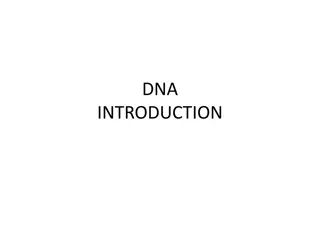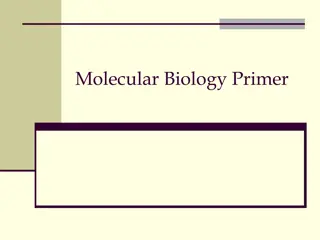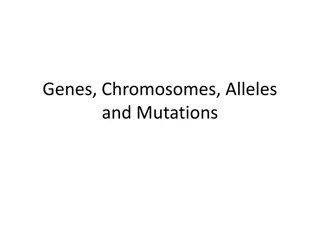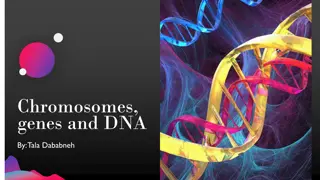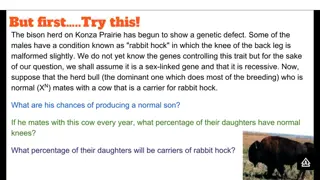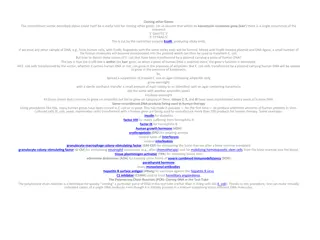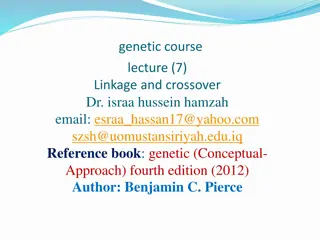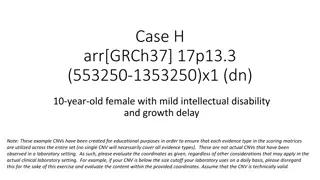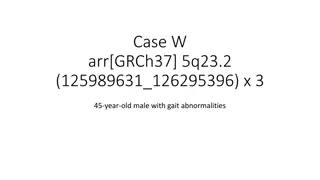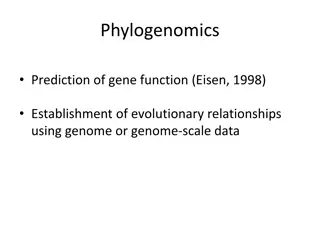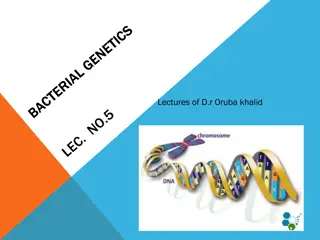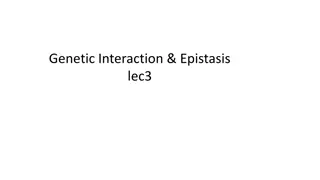Carcinogenesis
The multistep process of carcinogenesis at both phenotypic and genetic levels, including excessive growth, local invasion, and metastasis. Explore the six changes in normal cell physiology that result in cancer formation and the mechanisms of action of oncoproteins. Discover the role of important ge
7 views • 17 slides
Understanding Genetics: A Comprehensive Overview
Genetics is the study of genes, heredity, and variation in living organisms. This chapter explores key concepts such as phenotypes, genes, alleles, genotypes, and the laws of dominance. Through Punnett squares, the inheritance patterns of traits can be predicted, shedding light on how traits are pas
1 views • 35 slides
Understanding the Basics of Biology - Introduction to DNA, Genes, and Proteins
Explore the fundamental concepts of biology, including the human genome, protein coding genes, central dogma of biology, gene transcription, DNA vs. RNA, and more. Discover how DNA serves as the blueprint for life, how genes are translated into proteins, and the essential processes involved in gene
0 views • 57 slides
Genetic Linkage and Crossing Over Problems in Various Organisms
This content presents genetic problems on linkage and crossing over in different organisms such as corn, tomato, Drosophila, and rabbits. It describes the traits involved, crosses performed, and results obtained to calculate crossing over frequencies and distances between linked genes. The examples
0 views • 8 slides
Understanding Animal Genetics: A Comprehensive Overview
Animal genetics is the study of heredity, inheritance of traits from parents to offspring, genetic material like DNA, chromosomes, genes, alleles, and nucleotides. It involves the understanding of chromosomes in different livestock species, DNA as the carrier of genetic information, genes as units o
0 views • 67 slides
Unraveling the Mystery of Traits and Genes
Explore the fascinating world of traits and genes, understanding how they are passed down from parent to offspring through chromosomes. Delve into the role of genes in controlling various traits such as hair color, eye color, and even unique characteristics like detached earlobes and widow's peak. D
0 views • 11 slides
Understanding Transcription Factors and Regulatory Sequences in Gene Expression
Transcription factors play a crucial role in gene expression by controlling the recruitment of RNA polymerase. Promoter regions contain sequences like CAAT box and TATA box that regulate transcription by binding proteins. Consensus sequences are conserved patterns in the genome with various biologic
2 views • 10 slides
Understanding Sex-Linked Inheritance: Key Concepts and Examples
Sex-linked inheritance refers to the transmission of genetic traits determined by genes located on the sex chromosomes. This type of inheritance differs from autosomal inheritance due to the unique characteristics of the X and Y chromosomes. In organisms with XX/XY sex determination, genes on the X
1 views • 21 slides
Gene Prediction: Similarity-Based Approaches in Bioinformatics
Gene prediction in bioinformatics involves predicting gene locations in a genome using different approaches like statistical methods and similarity-based approaches. The similarity-based approach uses known genes as a template to predict unknown genes in newly sequenced DNA fragments. This method in
1 views • 40 slides
Understanding Structural Chromosomal Aberrations and Their Impact on Genetic Information
Chromosomal aberrations involve significant changes in chromosome structure and number, impacting multiple genes. These mutations can be structural or numerical, resulting in alterations such as deletions, duplications, inversions, and translocations. Deletions, for example, involve missing chromoso
0 views • 28 slides
Understanding Average Gene Effect and Breeding Value in Animal Genetics
In the field of animal genetics and breeding, it is crucial to comprehend the average effect of genes and breeding value of individuals. Genes are transmitted from parents to offspring through haploid gametes, influencing the genotype and breeding potential. Estimating the average effect of a gene i
4 views • 26 slides
Transcriptomic Changes in Peripheral Blood Mononuclear Cells of International Space Station Crew Members
The study analyzed transcriptomic changes in peripheral blood mononuclear cells of International Space Station crew members. Blood samples were collected before and after spaceflight, and differentially expressed genes were identified using RNA-seq analysis. Several genes, including CDKN1A (p21) and
0 views • 12 slides
Understanding Degree of Inbreeding and its Measurement in Animal Genetics and Breeding
Degree of inbreeding in animals is the extent to which genes are identical by descent within an individual. The coefficient of inbreeding, denoted by F, measures this degree and represents the increase in homozygosity in offspring from closely related matings. Two sources of homozygosity are genes a
0 views • 15 slides
Breast Cancer Genetic Variants and Treatment Guidelines
Recent research highlights the importance of genetic testing for cancer susceptibility genes in breast cancer patients to guide personalized treatment plans. Guidelines based on pathogenic variants in genes like BRCA1, BRCA2, and others provide insights on relative cancer risks and recommendations f
0 views • 21 slides
Contrasting Qualitative and Quantitative Traits in Genetics
Genetic traits in organisms can be qualitative or quantitative, with qualitative traits controlled by single genes and showing distinct variations, while quantitative traits are influenced by multiple genes and environmental factors, resulting in continuous variations. Qualitative genetics focuses o
0 views • 13 slides
Genetic Evaluation of 6-Month-Old Male with Tetralogy of Fallot
A 6-month-old male with Tetralogy of Fallot was assessed for a paternally inherited CNV at 15q13.2. The evaluation involved analyzing genes, overlap with established regions, haploinsufficiency predictors, gene number, and disease associations. The CNV contained 2 protein-coding genes without known
0 views • 13 slides
Genetic Manipulation in Environmental Biotechnology
Genetic manipulation strategies in environmental biotechnology involve techniques like gene splicing and molecular cloning to modify genes directly. These methods have various applications such as isolating genes, producing specific molecules, improving biochemical production, creating organisms wit
0 views • 20 slides
Understanding Sex-Linked Inheritance in Genetics
Explore the concept of sex-linked inheritance, where traits are determined by genes on sex chromosomes. Learn about X-linked and Y-linked characteristics, the patterns of inheritance in males and females, and examples of sex-linked traits like Hemophilia and Color blindness. Understand the implicati
1 views • 24 slides
How to Download Carbapenem Resistance Genes from NCBI Reference Gene Catalog
Learn how to download a list of all carbapenem resistance genes and point mutations from the NCBI Reference Gene Catalog for pathogen detection. Follow step-by-step instructions on accessing the catalog, applying filters to select carbapenem subclass, and downloading the data in tab-delimited format
1 views • 7 slides
Understanding Gene Regulation and Control of Gene Expression
This comprehensive content delves into the intricate mechanisms of gene regulation and control of gene expression. It covers topics such as transcriptional regulation, bacterial genes classification, and the role of regulatory proteins. Explore how genes are regulated at transcription, translation,
0 views • 17 slides
Understanding DNA: A Journey from Friedrich Miescher to Genes and Function
DNA, the hereditary basis of life, was first discovered by Friedrich Miescher in 1869. It consists of chromosomes, plasmids, and organellar DNA, collectively known as the genome. Genes, sequences of DNA, encode proteins and RNA, essential for an organism's functions. The genome is divided into chrom
0 views • 17 slides
Exploring the Evolution of Molecular Biology: From DNA Discovery to Genome Complexity
Uncover the fascinating journey of molecular biology, tracing key milestones from the discovery of DNA to the intricate structure of genes and genomes. Dive into historical breakthroughs, such as understanding the role of genes in producing proteins, the double helix structure of DNA, and the comple
2 views • 30 slides
Understanding DNA, Chromosomes, and Chromatin Structure
DNA is made up of genes, chromosomes, and chromatin. Genes carry vital information for protein synthesis, while chromosomes are condensed DNA required for cell division. Junk DNA are non-coding regions, and sister chromatids are identical DNA copies. Homologous chromosomes have matching structures,
1 views • 17 slides
Human Disease Symptom Network: Understanding Disease Relationships Through Symptoms and Genes
The Human Disease Symptom Network (HSDN) is constructed using a large-scale medical bibliographic records database to form a network of human diseases based on symptom similarities. By integrating disease-gene associations and protein-protein interaction data, correlations between symptom similarity
0 views • 37 slides
Understanding Genes, Chromosomes, Alleles, and Mutations in DNA
Explore the intricate world of genetics through genes, chromosomes, alleles, and mutations. Delve into the fundamental structures of DNA, such as nucleosomes and eukaryotic chromosomes. Gain insights into key genetic terms like genes, alleles, and genome composition. Learn about mutations, including
0 views • 11 slides
Understanding Meiosis and Genetic Variation in Organisms
Meiosis forms variable gametes in organisms, leading to increased genetic variation through the production of haploid gametes by meiosis I and II. Key concepts include homologous chromosomes, crossing over, independent assortment, and linked genes. Terminology such as homologous pairs and human chro
0 views • 29 slides
Understanding Chromosomes, Genes, and DNA in Genetics
This educational material explores the fundamentals of chromosomes, genes, and DNA, highlighting how genetic material is inherited from parents, determining traits such as eye color, blood type, and more. It explains the relationship between chromosomes, genes, and DNA, emphasizing their importance
0 views • 14 slides
Understanding Genetics: Chromosomes, Genes, and Inheritance
Genetics encompasses the study of chromosomes, genes, and inheritance patterns. Chromosomes are bar-like structures carrying DNA, with homologous pairs determining traits. Autosomes and sex chromosomes play roles in genetic makeup. Genes are hereditary units determining individual traits, with allel
0 views • 20 slides
Gene Pool Genes - Resource Gathering in Replication Phase
Essential genes required for nutrient intake during the replication phase to prevent elimination of your species. Loss of these genes results in dire consequences for survival. Follow the printing instructions for additional cards if needed.
0 views • 19 slides
Understanding Linked Genes and Genetic Mapping in Inheritance
Linked genes inherited together on chromosomes influence genetic traits. Discover the differences between sex-linked and linked genes, the concept of crossing over, linkage mapping, and the significance of gene distance in recombination. Explore the work of Alfred Sturtevant in gene mapping through
0 views • 21 slides
Cloning Other Genes and Recombinant DNA Technology
The recombinant vector with a kanamycin resistance gene can be used to clone other genes by inserting human DNA fragments and selecting transformed E. coli cells. This technique has enabled the production of various human proteins for therapeutic purposes, such as insulin, growth hormones, and clot-
0 views • 6 slides
Genetics II Jeopardy: Linked Genes, Genetic Mapping, and Sex Chromosomes
Explore the world of genetics with Genetics II Jeopardy, covering topics such as linked genes, genetic mapping, sex chromosomes, and inheritance patterns. Discover the significance of gene location on chromosomes, the concept of recombination frequency, and the role of specific genes like SRY in mal
0 views • 26 slides
Understanding Genetic Disorders and the Human Genome Project
The Human Genome Project, completed in 2003, aimed to identify all human genes and DNA sequences. Genetic disorders, like autosomal disorders and Huntington's disease, can result from mutations at different levels, affecting single genes, chromosomes, or multiple genes. Albinism and cystic fibrosis
0 views • 37 slides
Gene Coding Potential Analysis for Multiple Genes
Analysis of coding potential for six genes revealed details such as start positions, gene lengths, coding potential scores, and functional predictions. Genes exhibit various characteristics like RBS values, Blast results, and Family of unknown function classifications based on multiple analyses like
0 views • 25 slides
Understanding Linkage and Crossover in Genetics
Genes determining individual characteristics are carried in chromosomes, with some genes linked and inherited together. This linkage affects how genes assort in offspring, following principles of inheritance like Mendel's laws. The Chromosome Theory of Linkage explains how the distance between genes
0 views • 24 slides
Genetic Analysis of 17p13.3 Deletion in a 10-Year-Old Female
This genetic case study involves a 10-year-old female with a de novo 17p13.3 deletion, presenting with mild intellectual disability and growth delay. The deletion overlaps with the Miller-Dieker syndrome critical region, impacting genes associated with lissencephaly and cognitive impairment. Through
0 views • 19 slides
Evaluation of Genetic Abnormalities in a 45-Year-Old Male with Gait Abnormalities
A 45-year-old male with gait abnormalities was referred for evaluation, with an unknown inheritance and deceased parents. His father had a history of ataxia and tremor. Using the GAIN scoring metric, the genomic content was assessed, including the presence of protein-coding genes, established TS gen
0 views • 24 slides
Understanding Phylogenomics and Gene Function Prediction in Evolutionary Biology
Explore the significance of phylogenomics in predicting gene functions and establishing evolutionary relationships using genome-scale data. Learn about the challenges of using single genes or a few genes in phylogenetic analysis, the importance of analyzing multilocus data, and the need for multiple
0 views • 24 slides
Understanding Bacterial Genetics and DNA Structure
Explore the intricate world of bacterial genetics and DNA structure. Genes dictate the characteristics of bacteria, with each gene controlling specific properties. The double-stranded DNA structure, consisting of nucleotides and nitrogen bases, carries vital genetic information. Discover how genes a
0 views • 20 slides
Understanding Genetic Interaction and Epistasis in Biosynthetic Pathways
Genetic interaction and epistasis play crucial roles in determining phenotypic traits through the intricate network of genes, enzymes, and metabolic pathways. This concept is illustrated through a detailed explanation of how mutations in specific genes can affect the production of metabolites and ul
0 views • 24 slides

